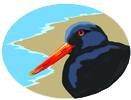
The Killdeer is named for what its call sounds like: “Kill-dee, Kill-dee, Kill-deer!” In fact, the Latin name, Charadrius vociferus, means “loudly vocal plover.”
The Killdeer is different from some members of its plover family because it has two breast bands and often is found far from water in a variety of open habitats—fields, lawns, gravel roads, streambeds, lakeshores, farmlands or ballparks.
The Killdeer is 9-11 inches long. It is brown on top and white underneath with medium-long pinkish legs. Besides the two black breast bands, it has a black band across its white forehead and a white eyebrow. White wing stripes and rusty-colored tails are visible in flight. Both sexes look alike. The downy chicks resemble some of their Charadrius family cousins and have just one dark breast band.
Killdeers eat mostly insects. They forage by running, then stopping, then quickly stabbing at the ground with their beaks. Their diet includes beetles, weevils, grasshoppers, caterpillars, ants, and dragonflies.
Killdeer nests are made in shallow depressions scraped out of sand, dirt, or gravel. Usually, four speckled and well-camouflaged eggs are laid and incubated for 24 days. A few days before they hatch, chicks communicate with their parents by peeping from inside the egg. A few hours after they hatch, they can run and forage on their own. Chicks look like mottled brown puffballs on toothpicks. They will fledge in about a month.
Photograph by Becky Bowen
